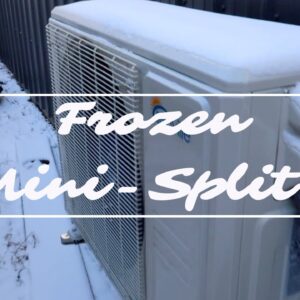The Practicalities and Performance of Mini Splits in Extreme Cold
[Music]
Hey everyone! Today’s video revolves around mini splits and their efficacy when the thermometer plummets. It’s an exploration that I think many will find illuminating, especially those of you eyeing a mini split system for your homes or garages in regions prone to severe cold. Recently, I installed a mini split in my garage, and the timing could not have been more impeccable: it’s been shivering at zero degrees, while the prior night registered a biting -8 degrees. The upcoming night promises another phase of equally punishing temperatures. Buckle up as we delve into whether the mini split manages to brave the cold.
[Music]
Before diving in, for those new to my channel, allow me to introduce myself. My content features a range of randomness, primarily centered on betterment. For instance, I’m in the midst of remodeling an over-century-old abandoned house, transforming it into an Airbnb. This project has spun off innumerable videos. You’ll also find automotive ventures here – ongoing car restorations and projects. Currently, my garage houses an ancient Audi perched on the lift. Now, let’s jump straight into the mini split and put its performance to the test.
Choice of Mini Split: Senville Leto 24,000 BTU
The particular mini split model I installed is the Senville Leto 24,000 BTU single head unit. This unit stands out for its higher BTU rating, which provides an interesting metric for those considering similar setups, be it garages, houses, or tiny homes with smaller BTU-rated units. The insights gathered here about cold weather performance will resonate more profoundly for those with smaller units. In my instance, though able to cope, the Leto unit barely maintains equilibrium.
Performance Metrics under Extreme Cold
As of the current reading, my garage thermometer registers 54 degrees Fahrenheit, whereas the mini split has been set to a cozy 62 degrees. Despite its efforts, the system fails to hit the target temperature. It’s been a relentless -8 degrees for the past 12 hours, now peaking at zero degrees. Forecasts suggest that these frigid conditions will persist, dipping back to sub-zero as nighttime rolls in. Let me frame this for context: where I reside, such cold spells aren’t outlandish yet remain infrequent – annually or biennially.
The mini split manages to maintain the garage at a chilly but tolerable low 50s. By garage standards, that’s somewhat admirable, especially when juxtaposed against the hostile exterior temperatures. This lukewarm result is sufficient for me, considering my usage context. However, it comes at the cost of perpetual operation, almost incessantly at full power, evident from the relentless din of the outdoor condenser.
Defrost Cycles and Their Implications
In addition to the constant struggle, every hour or so, the unit undergoes a defrost cycle lasting between 10 to 15 seconds. During this brief respite, heating ceases – a critical consideration for those contemplating reliance purely on mini splits for primary heating.
Given this backdrop, if you’re evaluating a mini split for your main living quarters or an essential workspace, heed the following: verify the unit’s rated minimum operational temperature. My unit, pegged at -5 degrees, is fighting an uphill battle below this rating. While managing, it’s clearly under duress. Hence, a backup heating strategy is prudent, especially where temperatures predictably plunge below the mini split’s rated capacity.
Auxiliary Heat Sources: Security in Redundancy
Supplementing your mini split with auxiliary heating is not mere cautiousness; it’s practical. Personally, while I presently lean on a propane tank heating system in my garage as a stopgap on days like today, understanding the limitations of mini splits under extreme conditions underscores the necessity of fallback options.
Even for scenarios involving tiny homes, where you might be relying predominantly on mini splits, securing an electric space heater as a contingency plan ensures peace of mind. The hypothetical of awakening to a frigid 40 degrees inside, frozen pipes, and cascading catastrophes underscores the prudence of redundancy.
Installation and Cost-Effectiveness
Dovetailing into the operational discussion is the setup and affordability spectrum of mini splits. The Senville Leto isn’t a plug-and-play solution like, say, a Mr. Cool unit. It requires more hands-on involvement – vacuuming down the system and self-releasing refrigerants, either via purchased or rented pumps. This installation complexity, though, delivers a significant cost advantage, with Senville Leto emerging more economically viable alongside superior BTU ratings when benchmarked against Mr. Cool counterparts.
Onwards in My Journey
Turning back to the broader narrative of my ventures, the house remodeling significantly preoccupies my current focus. Although my video series seems to suggest that it’s far from complete, the reality is much more advanced. From custom metal railing crafting to intricate welding tasks, a slew of fascinating content awaits. Parallel to this, car restoration projects – a couple of old BMWs queued for the upcoming winter-spring season – promise an exciting ride (pun intended).
Wrapping Up
My shop, equitably warm courtesy of the mini split, has maintained an acceptable comfort threshold even amidst formidable cold spells. The efficacy of my chosen mini split, while straining under extreme cold, has kept functional disruption at bay. However, as iterated, when reliance leans heavily on such systems for critical heating, validating rated temperature capacities and ensuring supplementary heating provisions cements a fail-safe approach.
To anyone teetering on the decision precipice, my honest recommendation is to invest heedfully, balancing rated specifications with contextual climate realities, ensuring that auxiliary support is always a stone’s throw away.
Thank you for journeying with me through this icy exploration. For more eclectic content ranging from house renovations, auto restorations, to the gyrating odyssey of mini splits, subscribe and stay tuned. And with that, gauging from YouTube’s hunch, check out the suggested video on your screen. It might just tickle your fancy.
[Music]

